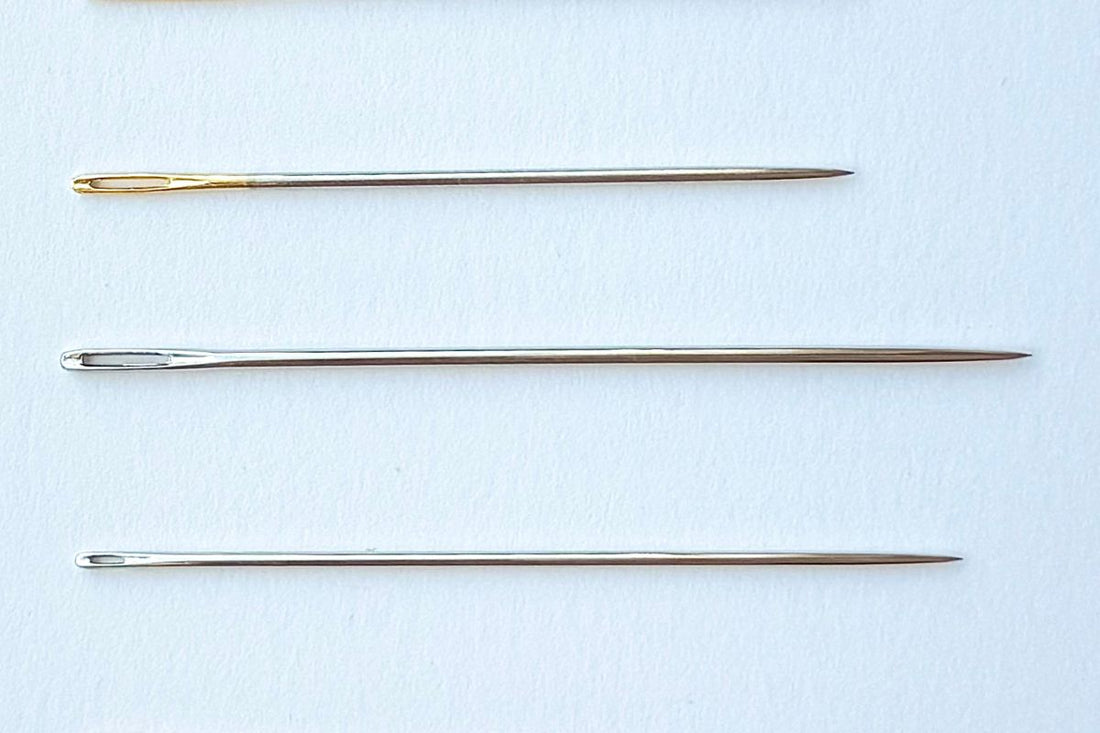
How to Choose a Hand-Sewing Needle
Share
 [From left to right: Sharp, Embroidery, Milliner, Darning, Sashiko, Tapestry]
[From left to right: Sharp, Embroidery, Milliner, Darning, Sashiko, Tapestry]
There are so many types of needles, it can feel overwhelming trying to choose the right one for a project. Rather than trying to memorize every type of needle, we think it's easier to focus on the project at hand and the thread or yarn you are using.
In our opinion, the size of the eye and the sharpness of the needle point are the two most important factors to consider. The width of the shaft may also be something to note if you're working with fabrics that are more delicate or, in contrast, heavy duty. Needle length may matter if you're, say, sewing sashiko stitches or a series of running or basting stitches, where you want to "load" multiple stitches at once on the needle.
Still confused? Not to worry! Below is our quick guide to commonly used hand-sewing needles, shown in these photos from left to right. We carry each type in our shop, so you can experiment with different kinds to find the needle(s) you like best!
 [From left to right: Sharp, Embroidery, Milliner, Darning, Sashiko, Tapestry]
[From left to right: Sharp, Embroidery, Milliner, Darning, Sashiko, Tapestry]
🪡 Sharps
Great for general purpose hand-sewing and everyday repairs on light to medium-weight fabrics like cotton, linen, or blended textiles. These needles are a versatile workhorse.
✨ Thread: Standard sewing thread (cotton, polyester, etc.)
✨ Needle: Slender body; small, sharp point. Smaller eye accommodates standard threads.
🪡 Embroidery
Used for embroidery and crewel but also visible mending - repair small holes or create delicate, detailed designs.
✨ Thread: Best suited for embroidery floss, silk thread, or other specialty threads
✨ Needle: Larger eye to accommodate multiple strands of thread. Slender body and sharp points for clean piercing of fabric.
🪡 Milliner
Great for precise, delicate work like sewing through multiple layers or working with lightweight or delicate fabrics.
✨ Thread: Fine silk, cotton, or polyester threads
✨ Needle: Long and slender with a small, round eye to handle delicate threads. Sharp points to glide through layers of fabric without causing damage.
🪡 Darning
Ideal for mending socks, sweaters, and other knits.
✨ Thread: Thicker threads like mending, wool, or cotton yarn
✨ Needle: Blunt tip to avoid splitting knit fibers, large eye to accommodate yarn.
🪡 Sashiko
Perfect for intricate, geometric stitches. Commonly used in visible mending.
✨ Thread: Well suited for thicker threads like sashiko thread or perle cotton
✨ Needle: Longer shaft (you can “load” several stitches at once) and a large eye to accommodate thicker threads.
🪡 Tapestry
Versatile needle used for stitching canvas, embroidery, or other larger/open-weave fabrics. Perfect for mending holes in knit items.
✨ Thread: Wool, cotton, or acrylic yarn
✨ Needle: Blunt tip to avoid splitting knit fibers. Larger eye to accommodate thicker yarns.
We could go on, but this is a good starting point. We hope you find the right needle for your project. If you have any questions, you can feel free to reach out to us at info@osanla.com.
